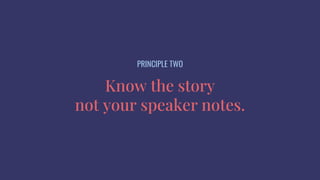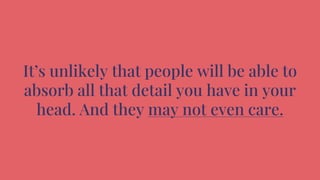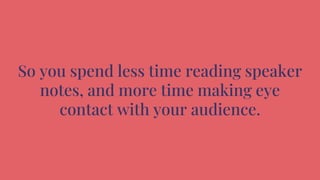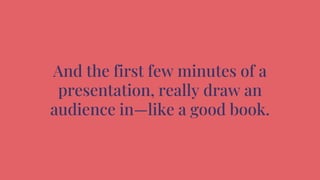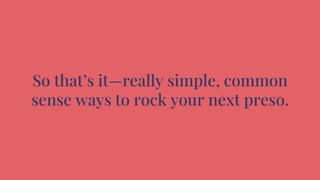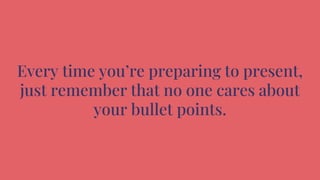No one cares about your bullet points & other common sense presentation practices
- 1. No one cares about your bullet points & OTHER COMMON-SENSE PRESENTATION PRACTICES BILL CHUNG
- 2. This is a deck about decks.
- 3. I’m a designer—but I think everyone can apply these simple principles.
- 4. If you’re a product manager, designer, or marketer (or anyone who needs to be convincing) this is for you.
- 5. Presenting well can mean the difference between success and failure.
- 6. Being able to clearly communicate and create understanding, gets people aligned and behind you.
- 7. And a lack of collective understanding of whatever you’re working on, is both toxic and costly.
- 8. To present a deck well, you need only follow a few simple principles.
- 9. Understand that no one cares about your bullet points. PRINCIPLE ONE
- 10. Does a slide in your deck look like this? ● Heads up: only a very special type of person will actually read what you write here ● In fact, if you have a slide like this in your deck, you’ll likely lose your audience before you hit the second bullet point ● So do yourself a favour, and stop worrying about wasting pixels ● There are a couple other reasons why no one will read this, but I’ll get into it into on a DIFFERENT SLIDE because you’re probably not reading this ● I’ve seen teams go completely off the rails because an important decision was hidden in an asinine list such as this monstrosity ● So don’t ever do this, unless you WANT to hide something, in which case you are either brilliant or a deviant of Machiavellian proportions ● Still reading? Great, don’t format slides like this, ever ● Because no one cares — which is a concern, because it’s probable someone in the room might need the context you’re trying to convey
- 11. When you use a lot of bullets, you spend more time on a single slide.
- 12. The problem is that humans have an attention span of about 8 seconds.
- 13. Remember how pissed you get when you see a YouTube ad? Those are five seconds.
- 14. So how long would it take for you to talk about these bullet points? ● Heads up: only a very special type of person will actually read what you write here ● In fact, if you have a slide like this in your deck, you’ll likely lose your audience before you hit the second bullet point ● So do yourself a favour, and stop worrying about wasting pixels ● There are a couple other reasons why no one will read this, but I’ll get into it into on a DIFFERENT SLIDE because you’re probably not reading this ● I’ve seen teams go completely off the rails because an important decision was hidden in an asinine list such as this monstrosity ● So don’t ever do this, unless you WANT to hide something, in which case you are either brilliant or a deviant of Machiavellian proportions ● Still reading? Great, don’t format slides like this, ever ● Because no one gives a fuck — which is a concern, because it’s probable someone in the room might need the context you’re trying to convey
- 15. Humans are impatient—and require constant stimulation.
- 16. So give it to them. Break up your thoughts into multiple slides to keep them engaged.
- 17. The act of condensing your key points into short statements, allows you to internalize the narrative.
- 18. Know the story not your speaker notes. PRINCIPLE TWO
- 19. A lot of people get intimidated by long presentations. Lots of slides and even more bullet points.
- 20. Have you ever worried about how you’re ever going to memorize it all?
- 21. It’s unlikely that people will be able to absorb all that detail you have in your head. And they may not even care.
- 22. It’s your job to make them care.
- 23. Think about the last time you had a traumatizing experience.
- 24. It’s likely, that the most minute detail of what happened, lingers in your mind.
- 25. It’s also likely that you could tell me that story, without needing to read a bunch of speaker notes.
- 27. Your presentation, need not be different.
- 28. Spend more time on crafting the narrative of your presentation, versus writing your speaker notes.
- 29. So you spend less time reading speaker notes, and more time making eye contact with your audience.
- 30. Make your first slide a blank one. BONUS TIP
- 31. So you’ve done a good job of getting your computer all setup before everyone piles into the meeting room.
- 32. But if you start with one of these slides...
- 33. Nicolas Crage Chief Madness Officer
- 34. People will just be gawking at the screen, when really, they should be focused on you.
- 35. A blank slide (literally a slide with nothing on it) allows the audience to focus on you.
- 36. And the first few minutes of a presentation, really draw an audience in—like a good book.
- 37. Use those first few minutes to introduce yourself, and talk shortly about what you’ll be presenting.
- 38. Bringing it all in
- 39. So that’s it—really simple, common sense ways to rock your next preso.
- 40. Every time you’re preparing to present, just remember that no one cares about your bullet points.
- 41. Focus less on conveying every single little detail: and more on storytelling, a timeless human tradition.
- 42. You’re obviously reading this because you care about the experience of listening to presentations.
- 43. And if you do it right, maybe your audience will care about what you have to say.
- 44. See you up there BILL CHUNG

















